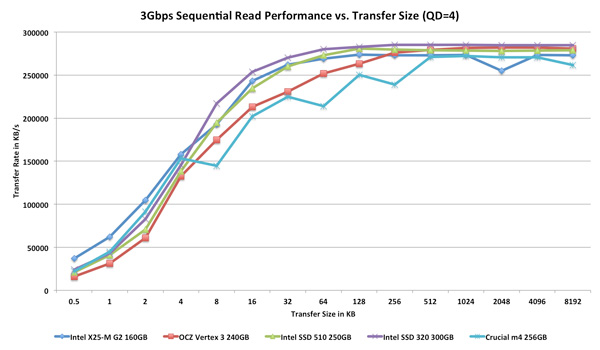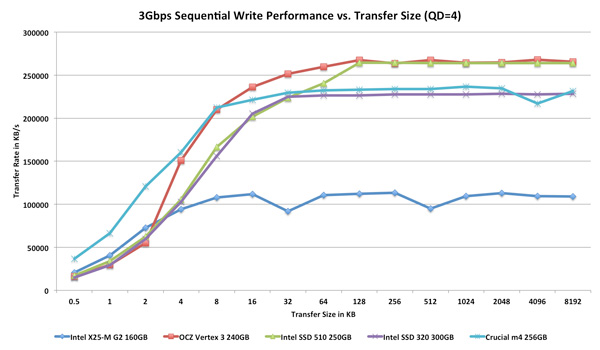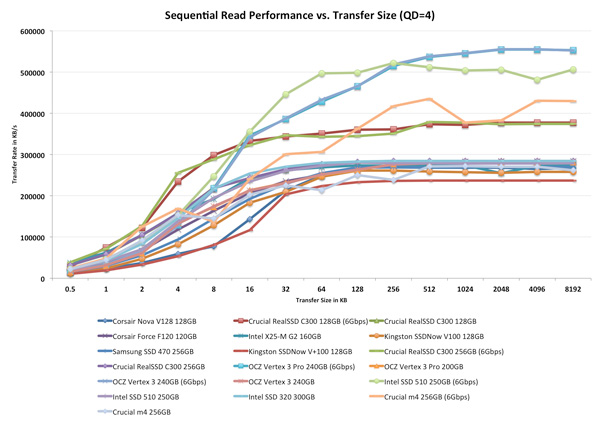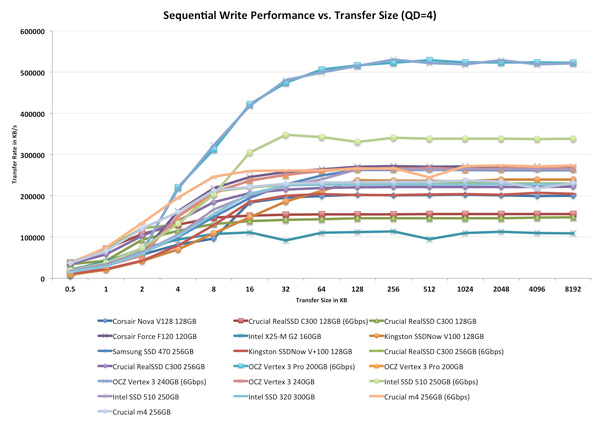The Intel SSD 320 Review: 25nm G3 is Finally Here
by Anand Lal Shimpi on March 28, 2011 11:08 AM EST- Posted in
- IT Computing
- Storage
- SSDs
- Intel
- Intel SSD 320
Performance vs. Transfer Size
All of our Iometer sequential tests happen at a queue depth of 1, which is indicative of a light desktop workload. It isn't too far fetched to see much higher queue depths on the desktop. The performance of these SSDs also greatly varies based on the size of the transfer. For this next test we turn to ATTO and run a sequential write over a 2GB span of LBAs at a queue depth of 4 and varying the size of the transfers.
I've created a second set of graphs that just looks at 3Gbps performance of a few drives to make things easier to read:
3Gbps sequential read/write performance at low queue depths is competitive with other 3Gbps drives as we've already seen. Intel's controller scales simlarly with transfer size as the Marvell controller used in the 510.
If you've got an AMD or Intel 6Gbps controller however you'll be let down by the performance of the 320:














194 Comments
View All Comments
LeTiger - Monday, March 28, 2011 - link
If Intel's not careful... they will price and performance themselves out of the very market they sought to create in the first place...nexox - Monday, March 28, 2011 - link
Meh, this is the cheapest SSD with some form of capacitor backup for volatile data - to get something similar you need to go to a SandForce 1500 or 2500 controller, and probably expect to pay 2-3x as much. Most people aren't too concerned with this, but it's an essential feature, no matter what the manufacturers say.It's also the only SSD I've seen that doesn't exhibit random latency spikes, that combined with the power fail protection means that it's the only SSD I'd consider buying.
cactusdog - Tuesday, March 29, 2011 - link
At least with Intel you are guaranteed to get best quality nand and reliable performance over the long term. Intel have also done the right thing by rebranding 25nm drives, even though in Intel's case performance is a little better than their 34nm drives.With OCZ, theres no way of knowing which nand you will get and you could end up with second rate nand not intended for high performance SSD's.
Intel's performance is very reliable over the long term, whereas OCZ/sandforce 3GB/s drives are known to slow to a "settled state" especially with smaller drives.
Intel will sell plenty of these drives because they are reliable and trustworthy.
Griswold - Tuesday, March 29, 2011 - link
Exactly. Not everybody plays benchmarks all day long and doesnt care one bit about reliability of the storage system.wumpus - Tuesday, March 29, 2011 - link
And just how many filesystems automatically write everything the instant write() is called? It is a bad idea for rotating media, and will take awhile before filesystems optimized for SSDs show up (Microsoft has been promising a database centric filesystem for the "next windows" since NT was new. Maybe someday.) Also, NTFS has corruption issues with standard hard drives, this isn't going to help that reliability much anyway. You need backups, a real UPS, and RAID (in roughly that order) if you care about data reliability.If intel was willing to compete largely on reliability, they could double the price (if data on SRAM competition is even more expensive), as such a feature is worth much more than any amount of hardware cost to a large number of customers. Don't expect to get it without major software surgery (and yes, some of those customers have the software).
seapeople - Tuesday, March 29, 2011 - link
I don't understand all the negative feedback on this drive. For the 90% of us who have 3Gbps SATA, compared to the Vertex 3 this drive is:~25% slower than Vertex 3
~20% cheaper than Vertex 3
Why is that so terrible, the Vertex 3 is an amazing performance feat, and under common mainstream conditions this drive is about equal on a price/performance basis.
Meanwhile, this drive gives us 20% more performance than the g2 generation while being ~20% cheaper. This is far from sad.
dagamer34 - Tuesday, April 5, 2011 - link
Except the MSRP for a 120GB Vertex 3 is cheaper than what an equally sized Intel SSD 320 series drive costs. That's simply laughable. Higher price for worse performance? Throwing up the "reliability" card is a red herring when you consider that the 25nm process is brand new, you don't get to state that for any technology until it's been around on the market for quite some time (otherwise, it's just name recognition only, and that worked so well for Sandy Bridge chipsets).seapeople - Thursday, April 7, 2011 - link
You're on crack. A 120 GB Vertex 3 is listed as 249.99 versus 209.00 for the 120 GB Intel SSD 320.Furthermore, SSD reliability issues generally arise from controller/firmware nuances and bugs, not the new process node. It sounds like the SSD 320 is basically the g2 with new flash and a few features unlocked, so it's reasonable to expect similar controller reliability. Apart from that, basically everyone uses the same flash anyway, so if the Intel drive dies because of the new flash process then so will the Vertex.
andreyu - Thursday, July 21, 2011 - link
1. you're blind or on crack2. you bought a ocz/corsair ssd cause you wanted speed but returned it for problems and now you're mad on intel?
3.so sorry 4 u
120 GB Intel SSD 320 is CHEAPER than 120 GB Vertex 3
TonyB - Monday, March 28, 2011 - link
lol